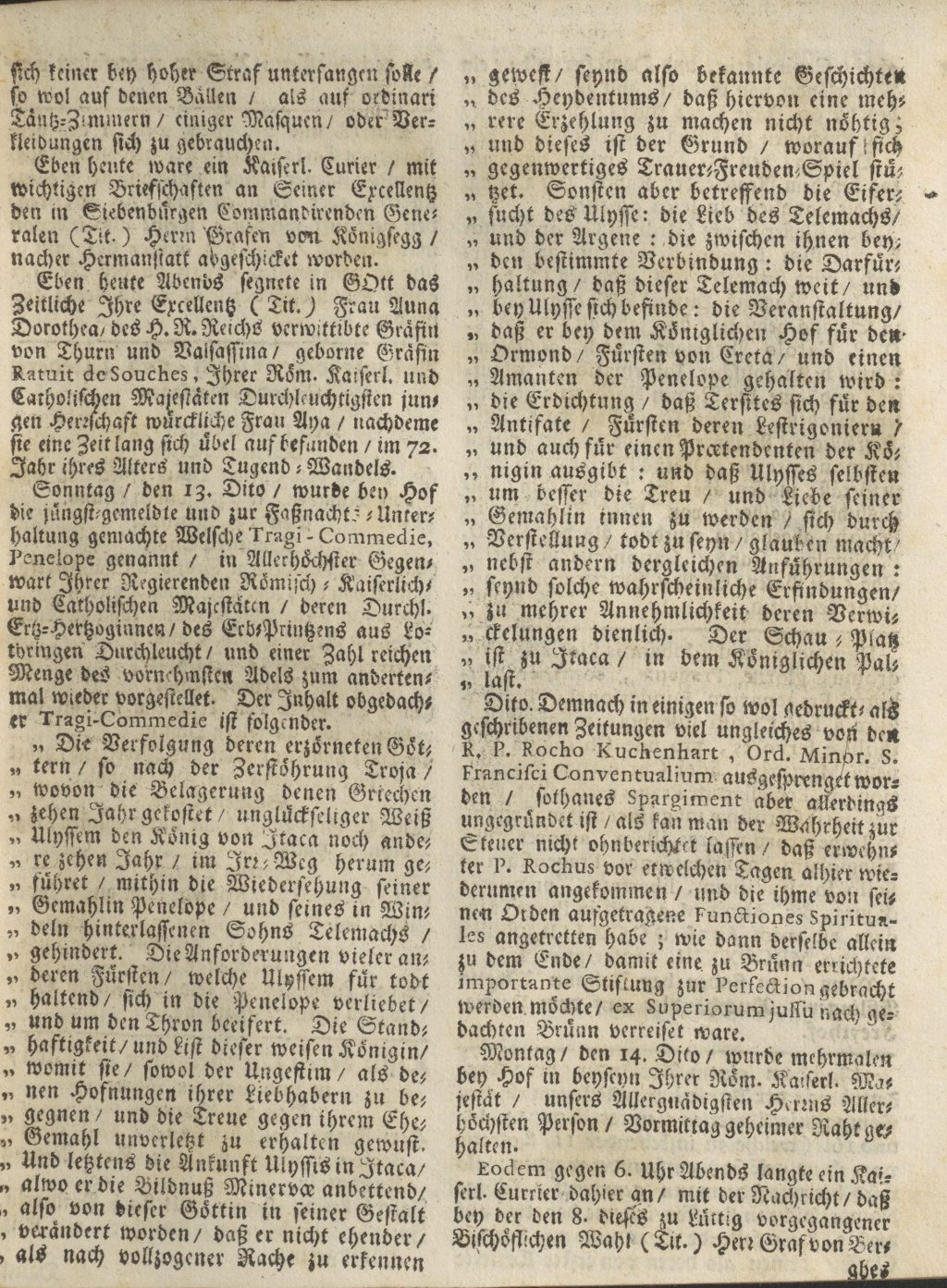Plot
The plot of Penelope is based on the ancient story of Homer’s Odyssey and draws mainly on the last two cantos (23 and 24), dealing with Odysseus’ return home and his reunion with his wife Penelope. After more than 20 years, Odysseus returns to Ithaca from his adventures. He is worried about his wife Penelope and therefore disguises himself in order to test her faithfullness and at the same time ward off the numerous lovers surrounding her.
The homecoming of Odysseus has repeatedly been the subject of opera libretti, beginning with Giacomo Badoaro’s Il ritorno di Ulisse in Patria, set to music by Claudio Monteverdi in 1642. Pietro Pariati, the librettist of Conti's Penelope, drew on two texts that already bore the name of the female title character: firstly, the opera libretto Penelope la casta by Nicolò Minato (Vienna 1670, music by Antonio Draghi), which in turn was the inspiration for Matteo Noris’ Penelope la casta (Venice 1685, music by Carlo Pallavicino, Alessandro Scarlatti and others). In 1707, while still in Milan, Pariati wrote a stage play about the Penelope story, from which he took many elements and the roles for the later opera libretto. All the texts treat the ancient material as tragicomedy, which means they are characterized by the insertion of comic characters and comical disguise scenes and role changes.
In modern terms, the plot is about an extreme form of long-distance relationship, about fidelity, trust, mistrust, greed for power and love: Ulisse has barely set foot on his home soil again after 20 years when he doubts his wife's fidelity. To challenge her, he swaps roles with his servant Tersite, who is supposed to seduce Penelope as the “false prince” Antifate so that Ulisse can catch his wife in the act. The fact that this plan doesn’t quite work out and takes unforeseen turns is already pre-programmed by the genre of tragicomedy. Ulisse is particularly jealous of the young, handsome Prince Ormondo, who appears to be very close to Penelope - unaware that he is his own son Telemaco, who is also disguised for his protection, given that he is the future heir to the throne. He has long been engaged to Princess Argene, whom he will meet for the first time in the course of the opera. Other contenders for the throne are the gentle Eurimaco and the testosterone-driven, power-obsessed Medonte. Penelope and her servant Dorilla embody the smart women who cunningly don’t let on that they see through the men’s supposedly well-considered plans.
Due to the many disguises and the resulting more or less successful role changes that exceed the social hierarchies, and because of the comical servant characters Dorilla and Tersite, the plot thrives on mix-ups, confusion and amusing scenes alongside moments of great emotion.
It is exciting to see how Pariati and Conti will interpret the Penelope story: Does the great explorer and adventurer Ulisse behave like a hero and ideal ruler once he finds himself back in everyday life? Is his mistrust justified? Will the false prince Tersite succeed with Penelope? Will Eurimaco and Medonte also get a chance? How will Prince Ormondo (Telemaco) and Ulisse react to each other? Will Penelope recognize Ulisse’s game? Will Ulisse and Penelope reconcile and find their way back to each other? Who will sing the opera’s great love duet? Will Tersite be impressed by Dorilla’s impressive but harmless magic and distracted from his mission?
Answers, great emotions and witty suprises will be presented at the performances of PENELOPE 2025!
For everyone who would like to learn about the plot in advance: Both the Italian and German libretti contain brief summaries of the plot, drawing on the story told by Homer in the Odyssey. A short, enumerated summary of the central events and conflicts of the plot recalls the story and the settings and familiarizes the reader with the expected role changes. The synopsis from the German libretto was reproduced verbatim in the report on the premiere on February 13, 1724 in the Wienerisches Diarium (February 16, 1724); however, as was customarily in these cases, the report does not mention any details about the performers.

Report from 13.2.1724, in: Wienerisches Diarium Nr. 14, 16. Februar 1724, [p. 7].
Literature
Livio Marcalatti, "Die keusche Penelope und der zornige Odysseus: Kursieren einer tragikomischen Opernhandlung zwischen Wien und Norditalien", in: Musicologica Brunensia 53 / 2018 / Supplementum. https://doi.org/10.5817/MB2018-S-7
Livio Marcalatti, "La tragicommedia per musica alla corte di Vienna nel primo Settecento. Un genere di importazione o una creazione della corte imperiale?", in: Römische Historische Mitteilungen, 65. _Band/2023, pp. 115–133.
Claudia Michels, Karnevalsoper am Hofe Kaiser Karls VI. 1711–1740. Kunst zwischen Repräsentation und Amusement (Publikationen des Instituts für österreichische Musikdokumentation 41), Vienna: Hollitzer 2019, pp. 252–267.




